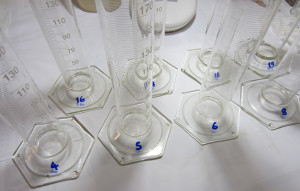Keeping it cool
October 7th, 2015 | Bodega
 This may well be my last post relating to the 2015 harvest – not because our fermentations are complete, but mostly because there is not much more that can be said about the winemaking process. At this point we are merely observers, monitoring progress by measuring the density of the must/wine, and then, according to what we see, perhaps making one or two subtle adjustments to the temperature control. The idea is that we have a slow, smooth transition from grape juice into wine and at this point the only form of control that we have is temperature. If the fermentation starts to move too quickly then by reducing the temperature by a decimal place or two, then we can slow things down just a touch. Conversely, if the fermentation looks as though it might be sticking, putting too much stress on the yeast, then we can help it along by increasing the temperature. Once all the sugar has been consumed and the fermentation has come to an end, we simply add a good dose of SO2 to inhibit spoilage and kill any unwanted bacteria (e.g. malolactic bacteria). Et voila, done!
This may well be my last post relating to the 2015 harvest – not because our fermentations are complete, but mostly because there is not much more that can be said about the winemaking process. At this point we are merely observers, monitoring progress by measuring the density of the must/wine, and then, according to what we see, perhaps making one or two subtle adjustments to the temperature control. The idea is that we have a slow, smooth transition from grape juice into wine and at this point the only form of control that we have is temperature. If the fermentation starts to move too quickly then by reducing the temperature by a decimal place or two, then we can slow things down just a touch. Conversely, if the fermentation looks as though it might be sticking, putting too much stress on the yeast, then we can help it along by increasing the temperature. Once all the sugar has been consumed and the fermentation has come to an end, we simply add a good dose of SO2 to inhibit spoilage and kill any unwanted bacteria (e.g. malolactic bacteria). Et voila, done!
The first tanks that we seeded are not too far from completion now and are almost at a point where they are starting to reveal the true character of the vintage. Until now the natural fruit sugar has been quite dominant, albeit that by tasting we can still judge the concentration, style and overall balance of the developing wine. The result is that we are quietly confident that this year’s wine will be very good, and the fact that we started with some excellent quality, healthy fruit was certainly an essential element in this outcome. This may well be my last post relating to the 2015 harvest – not because our fermentations are complete, but mostly because there is not much more that can be said about the winemaking process. At this point we are merely observers, monitoring progress by measuring the density of the must/wine, and then, according to what we see, perhaps making one or two subtle adjustments to the temperature control. The idea is that we have a slow, smooth transition from grape juice into wine and at this point the only form of control that we have is temperature. If the fermentation starts to move too quickly then by reducing the temperature by a decimal place or two, then we can slow things down just a touch. Conversely, if the fermentation looks as though it might be sticking, putting too much stress on the yeast, then we can help it along by increasing the temperature. Once all the sugar has been consumed and the fermentation has come to an end, we simply add a good dose of SO2 to inhibit spoilage and kill any unwanted bacteria (e.g. malolactic bacteria). Et voila, done!
This may well be my last post relating to the 2015 harvest – not because our fermentations are complete, but mostly because there is not much more that can be said about the winemaking process. At this point we are merely observers, monitoring progress by measuring the density of the must/wine, and then, according to what we see, perhaps making one or two subtle adjustments to the temperature control. The idea is that we have a slow, smooth transition from grape juice into wine and at this point the only form of control that we have is temperature. If the fermentation starts to move too quickly then by reducing the temperature by a decimal place or two, then we can slow things down just a touch. Conversely, if the fermentation looks as though it might be sticking, putting too much stress on the yeast, then we can help it along by increasing the temperature. Once all the sugar has been consumed and the fermentation has come to an end, we simply add a good dose of SO2 to inhibit spoilage and kill any unwanted bacteria (e.g. malolactic bacteria). Et voila, done!
The first tanks that we seeded are not too far from completion now and are almost at a point where they are starting to reveal the true character of the vintage. Until now the natural fruit sugar has been quite dominant, albeit that by tasting we can still judge the concentration, style and overall balance of the developing wine. The result is that we are quietly confident that this year’s wine will be very good, and the fact that we started with some excellent quality, healthy fruit was certainly an essential element in this outcome.


